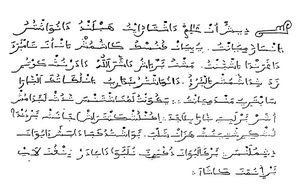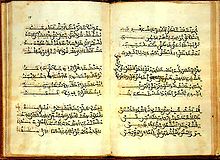Aljamiado


Aljamiado (Spanish: [alxaˈmjaðo]; Portuguese: [aɫʒɐmiˈaðu]; Arabic: عَجَمِيَة trans. ʿajamiyah [ʕaʒaˈmij.ja]) or Aljamía texts are manuscripts that use the Arabic script for transcribing European languages, especially Romance languages such as Mozarabic, Aragonese, Portuguese, Spanish or Ladino.
According to Anwar G. Chejne,[2] Aljamiado or Aljamía is "a corruption of the Arabic word ʿajamiyah (in this case it means foreign language) and, generally, the Arabic expression ʿajam and its derivative ʿajamiyah are applicable to peoples whose ancestry is not of Arabian origin". During the Arab conquest of Persia, the term became a racial pejorative.[3] In linguistic terms, the Aljamía is the use of the Arabic alphabet to transcribe a Romance language. It was used by some people in some areas of Al-Andalus as an everyday communication vehicle,[citation needed] while Arabic was reserved as the language of science, high culture, and religion.
The systematic writing of Romance-language texts in Arabic scripts appears to have begun in the fifteenth century, and the overwhelming majority of such texts that can be dated belong to the sixteenth century.[4] A key aljamiado text was the mufti of Segovia's compilation Suma de los principales mandamientos y devediamentos de nuestra santa ley y sunna, of 1462.[5]
In later times, Moriscos were banned from using Arabic as a religious language, and wrote in Spanish on Islamic subjects. Examples are the Coplas del alhichante de Puey Monzón, narrating a Hajj,[6] or the Poema de Yuçuf on the Biblical Joseph (written in Aragonese).[7]
Usage by the Moriscos during the persecution of Muslims in Spain[]

Aljamiado played a very important role[citation needed] in preserving Islam and the Arabic language in the life of the Moriscos of Castile and Aragon; Valencian and Granadan Moriscos spoke and wrote in Andalusi Arabic. After the fall of the last Muslim kingdom on the Iberian peninsula, the Moriscos (Andalusi Muslims in Granada and other parts of what was once Al-Andalus) were forced to convert to Christianity or leave the peninsula. They were forced to adopt Christian customs and traditions and to attend church services on Sundays. Nevertheless, some of the Moriscos kept their Islamic belief and traditions secretly through the usage of Aljamiado.
In 1567, Philip II of Spain issued a royal decree in Spain, which forced Moriscos to abandon using Arabic on all occasions, formal and informal, speaking and writing. Using Arabic in any sense of the word would be regarded as a crime. They were given three years to learn the language of the Christian Spanish, after which they would have to get rid of all Arabic written material. Moriscos of Castile and Aragon translated all prayers and the sayings of their Prophet Mohammed into Aljamiado transcriptions of the Spanish language, while keeping all Qur'anic verses in the original Arabic. Aljamiado scrolls were circulated amongst the Moriscos. Historians came to know about Aljamiado literature only in the early nineteenth century. Some of the Aljamiado scrolls are kept in the Spanish National Library in Madrid.
Other uses[]
The practice of Jews writing Romance languages such as Spanish, Aragonese or Catalan in the Hebrew script is also referred to as aljamiado.[8]
The word aljamiado is sometimes used for other non-Semitic language written in Arabic letters:
- Bosnian and Albanian texts written in Arabic script during the Ottoman period have been referred to as aljamiado. However, many linguists prefer to limit the term to Romance languages, instead using Arebica to refer to the use of Arabic script for Slavic languages like Bosnian.
- The word Aljamiado is also used to refer to Greek written in the Arabic/Ottoman alphabet.[9]
- The word Aljamiado could also apply for the recent use of Arabic/Magrebi script by present-day Spanish Muslims to write in Catalan[10] and Valencian.[11]
See also[]
- Mozarabic language
- Kharjas
- Category:Arabic alphabets
- Arabic Afrikaans
- Karamanli Turkish
- Jawi (script)
- Ajami script
- Arebica
- Elifbaja shqip
- Xiaoerjing
- Judeo-Spanish
References and notes[]
- ^ The passage is an invitation directed to the Spanish Moriscos or Crypto-Muslims so that they continue fulfilling the Islamic prescriptions in spite of the legal prohibitions and so that they disguise and they are protected showing public adhesion the Christian faith.
- ^ Chejne, A.G. (1993): Historia de España musulmana. Editorial Cátedra. Madrid, Spain. Published originally as: Chejne, A.G. (1974): Muslim Spain: Its History and Culture. University of Minnesota Press. Minneapolis, USA
- ^ Frye, Richard Nelson; Zarrinkoub, Abdolhosein (1975). "Section on The Arab Conquest of Iran". Cambridge History of Iran. London. 4: 46.
- ^ L.P. Harvey. "The Moriscos and the Hajj" Bulletin of the British Society for Middle Eastern Studies, 14.1 (1987:11-24) p. 15.
- ^ "Summa of the principal commandments and prohibitions of our holy law and sunna". (Harvey 1987.)
- ^ Gerard Albert Wiegers, Islamic Literature in Spanish and Aljamiado 1994, p. 226.
- ^ MENÉNDEZ PIDAL, Ramón, Poema de Yuçuf: Materiales para su estudio, Granada, Universidad de Granada, (1952) p. 62-63
- ^ "Unveiling Judeo-Spanish Texts: A Hebrew Aljamiado Workshop".
- ^ Balim-Harding, Çigdem; Imber, Colin, eds. (2010-11-20). The Balance of Truth. Gorgias Press. doi:10.31826/9781463231576. ISBN 978-1-4632-3157-6.
- ^ Abstract: Aquest document es un text en català que he seleccionat d'internet i que després lo he transcrit en grafía àrabo-magribina; es tracte d'una traducció d'un menut fragment de la cèlebre obre "Qawa'id Al-Islam" (Fonaments de l'Islam) de lo Qadi 'Iyad de Ceuta (1083–1149, rahimahullah), qui fou un famós alfaquí (juriste) de l'Escola de Jurisprudencia Maliki de l'Islam Sunnita. Lo fragment fou traduit en llengüe catalana per l'antigue Associació Catalana d'Estudis Islàmics. La senyera de l'Antiga Corona d'Aragó amb l'estrelle Rub' Al-Hizb incrustade l'he inclos en memoria de les Aljames (comunitats) Islàmiques de lo que fou la Corona d'Aragó, especialment, i per lo que toca en aquest text, les Aljames de lo que llavors ere lo Principat de Catalunya. [1] - Mahomat Abrahim Bosch Ramon ([2]) - Accessed on 09 April 2021
- ^ Abstract: Este document és una edició que haig fet jo mateix de la Sura Al-Fátiha (Sura de l'Obertura), primera Sura (capítol) de l'Alcorá, que tot Musulmá recite en les cinc Salawāt (pregáries) diàries. L'edició inclou, primer, el text en Árab al-Fuṣḥá (clássic) i que inclou un manuscrit d'eixa mateixa Sura en escriptura Magrebí procedent de l'Antic Califat de Sokoto en lo que hui és Nigeria; després la traducció en Catalá occidental i Valenciá 'Aljamiat' (escrit en carácters Arábics) que haig preparat jo mateix; finalisant ab lo text Catalá occidental i Valenciá 'Llatinat' (escrit en carácters Llatins). En la part esquerre de la primera fulla represente la Senyera ("Sinyal" en Aragonés) de l'Antiga Corona d'Aragó ab l'estrella Rubʿ al-ḥizb ("la quarta part" en Arábic), aixina com l'Ax-Xahāda (Professió de Fe de l'Islam) en lo seu interior; açó ho haig fet en memória dels 'Moros' i 'Moriscos' (Musulmans i Cripto-Musulmans, respectivament) de tota l'Antiga Corona d'Aragó (Regnes de Valéncia i Aragó, Principat de Catalunya), que foren finalment desterrats entre 1609-1610. L'edició del text Aljamiat ha sigut possible grácies a una taula d'alfabet Aljamiat Morisc Castellá del segle XVI que haig afegit al final del text. [3] - Mahomat Abrahim Bosch Ramon ([4]) - Accessed on 09 April 2021
Further reading[]
- Los Siete Alhaicales y otras plegarias de mudéjares y moriscos by Xavier Casassas Canals published by Almuzara, Sevilla (Spain), 2007. (in Spanish)
External links[]
- A bilingual Arabic-aljamiado Qur'an from the fifteenth century
- Aljamiado (Texts and Studies)
- Alhadith: Morisco Literature & Culture A website devoted to the literature and language of the Moriscos; contains a multilingual bibliography, digital texts, and a catalogue of aljamiado-morisco manuscripts.
- 15th century in Al-Andalus
- Arabic alphabets
- Spanish language
- Moriscos